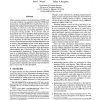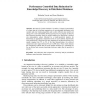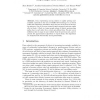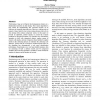VLDB
1995
ACM
14 years 5 months ago
1995
ACM
Object-oriented and object-relational databases(OODB) need to be able to load the vast quantities of data that OODB users bring to them. Loading OODB datais significantly more com...
VLDB
1997
ACM
14 years 5 months ago
1997
ACM
A new access method, called M-tree, is proposed to organize and search large data sets from a generic "metric space", i.e. where object proximity is only defined by a di...
PAKDD
2000
ACM
14 years 5 months ago
2000
ACM
The objective of data reduction is to obtain a compact representation of a large data set to facilitate repeated use of non-redundant information with complex and slow learning alg...
ESA
2006
Springer
14 years 5 months ago
2006
Springer
Data representing moving objects is rapidly getting more available, especially in the area of wildlife GPS tracking. It is a central belief that information is hidden in large data...
FGR
2004
IEEE
14 years 5 months ago
2004
IEEE
We present a new unsupervised learning technique for the discovery of temporal clusters in large data sets. Our method performs hierarchical decomposition of the data to find stru...
GIS
1992
ACM
14 years 6 months ago
1992
ACM
Machine learning techniques such as tree induction have become accepted tools for developing generalisations of large data sets, typically for use with production rule systems in p...
VL
1996
IEEE
14 years 6 months ago
1996
IEEE
Understanding and interpreting a large data source is an important but challenging operation in many technical disciplines. Computer visualization has become a valuable tool to he...
SSDBM
1996
IEEE
14 years 6 months ago
1996
IEEE
Knowledge discovery in databases and data mining aim at semiautomatic tools for the analysis of large data sets. We give an overview of the area and present someof the research is...
DMKD
1997
ACM
14 years 6 months ago
1997
ACM
Partitioning a large set of objects into homogeneous clusters is a fundamental operation in data mining. The k-means algorithm is best suited for implementing this operation becau...
CHI
1997
ACM
14 years 6 months ago
1997
ACM
Flip zooming is a novel focus+context technique for visualizing large data sets. It offers an overview of the data, and gives users instant access to any part. Originally develope...




